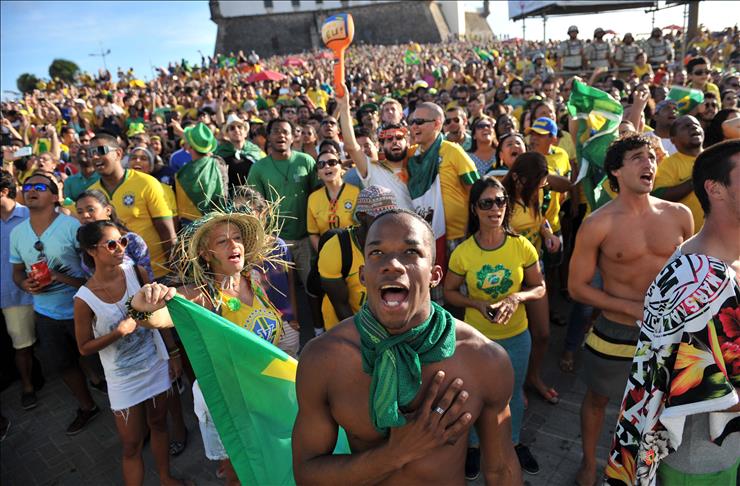
SAO PAULO, Brazil
Exactly who brought football to Brazil and precisely when they did it is still a moot point: some say it was Charles Miller, the son of a British railway worker who was building train lines in São Paulo, and others point to Thomas Donohue, a dye worker from Busby in Scotland, who sowed the soccer seed in Rio de Janeiro – both sometime around the late 1890s.
However, the sport made the 9,000-kilometer leap from Britain and some 120 years later Brazil has earned the title of O País do Futebol – the Land of Football.
Although limited originally into Brazil's élite, football spread and transcended social divides, uniting the country in ways that samba, Carnival and beach culture never have.
“Football speaks so deeply to Brazilians that it has made them challenge authority over and over – and they could keep doing it,” Mauricio Savarese, Brazilian football writer and co-author of the recently-released “A to Zico,” told the Anadolu Agency.
“First, it was the working class who challenged their bosses and kept playing even during work. Then it was the black population, many former slaves, who forced their way into the sport in the 1920s,” Savarese explained.
The football writer pointed out how football-crazed Brazilians even challenged the military during the 1964-1985 dictatorship, through banners, chants and subversive meetings that were often held in football stadia.
These days Brazilian men and women of all ages, ethnicities and social classes can be seen ardently supporting their favorite team during the nation's domestic championships.
When the World Cup comes around, however, that passion swells to a frenzy every four years as the country rallies around the national squad, the Seleção.
For that month of football, the national squad attains deity-like status. During the latest World Cup build up, local media searched for player lookalikes; football stickers were eagerly swapped among fans; and glamorous magazine covers filled newsstands.
It was this that I had expected for my first World Cup as a correspondent in Brazil: nothing less than a joyous, rapturous atmosphere. A sea of green and yellow from a nation plainly in love with football.

Muted build-up
However, the vast majority of that long build-up to the tournament was bogged down in criticisms and negativity. Delays and fatalities at building sites. Corruption and government overspending. Violent protests that were met with a fierce police crackdown.
The bad news kept coming and the result was a seriously lackluster build-up to the tournament: the traditional murals and chalk drawings on the roads were largely absent; the green-and-yellow bunting was nowhere to be seen.
But this has now suddenly changed.
In a poor community next to São Paulo's World Cup stadium during last week's opening match there was a raucous party: barbecues were sizzling, beer was flowing and music filled the air, so loud it vibrated right through you.
“It's really exciting. Brazil has been waiting a long time to host the World Cup again, and finally it's here! Neymar is our best chance for victory!” 24-year-old student Thiago Araújo, from São Paulo, said.
“Some weeks back I wasn’t very excited, because of the state of the country. But now that I’m really feeling the atmosphere of the Cup, I am much more excited. With football, all of Brazil forgets its sadness and its problems” said Neusilia Ramos, 62, a retired shopkeeper in Brasília.
The pressure on Brazil's team is palpable and nothing short of a win at each game – which would mean a historic sixth World Cup victory – will do for most.
Judging by what we see on television and some of the tales my far-flung colleagues have told, a similar party mood can now be found throughout Brazil.
Vuvuzelas, flags and wigs

This excitement peaked as Brazil's national side took to the turf in their second World Cup fixture on Tuesday: green-and-yellow flags adorned cars and houses, people were dancing in the streets with festive wigs and dyed hair; televisions and vuvuzelas blared out everywhere.
Many Brazilians had been given the afternoon off to watch the match and the streets immediately suffered as a result: traffic in São Paulo's already-congested roads rocketed to over 300 kilometers of clogged roads.
It was a very clear sign that a small number of critics have been drowned out by the vast majority of Brazilians who want to put the negativity behind them and enjoy the World Cup now that it is in Brazil – the first time since 1950.
“Brazilians have come to their senses and the World Cup is being received as the great event it is and not as one to transform the country dramatically,” Savarese said in conclusion.
“Brazilian sentiment is very volatile: one minute everyone boos; the next they're clapping ferociously.”
And this is what appears to have happened with the World Cup over the last year: many Brazilians were perhaps understandably swept up in the emotion of last year's mass protests, when over a million people in more than 300 cities across the country.
Although protests have continued, they are tiny in comparison with the numbers seen last year.
After a far-from-perfect build-up to the World Cup, Brazil appears to have allowed the excitement of hosting football's biggest event to grip the nation perhaps most closely identified with the ethos of the beautiful game.


